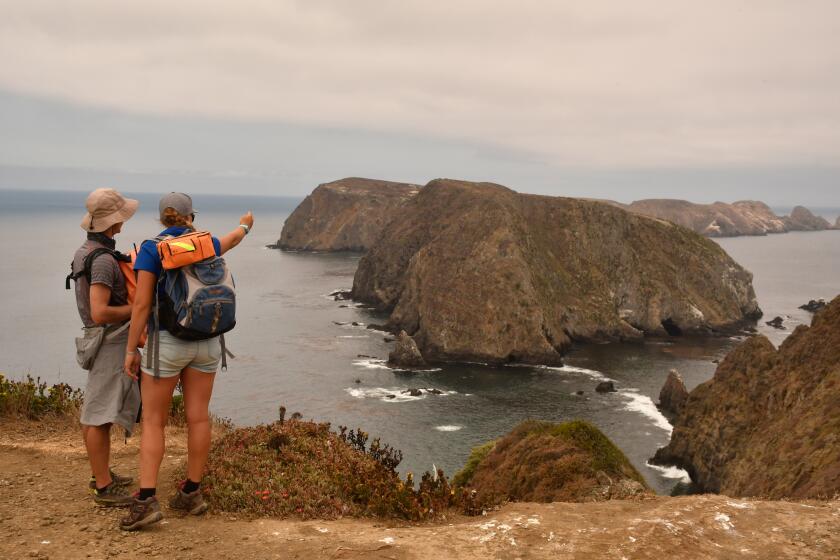Fighting the Fish All Alone
- Share via
TRANQUILITY, Calif. — For any California farmers who somehow have failed to grasp how far their place in the social pecking order has fallen, the federal government’s decision last week to suspend all water deliveries to farmers on the San Joaquin Valley’s west side should have sent a clear message.
The feds, forced to balance between the water needs of 7,000 farms and 191 chinook salmon, came down on the side of the fish. There were, of course, complications. A long drought, the 1973 Endangered Species Act, tricky hydraulics and salmon spawning habits all pretty much forced the U.S. Bureau of Reclamation to turn off the tap for this year.
Not that this consoled the growers around here. They rely on the dams and canals of the Central Valley Project to water their cotton, tomatoes and other crops, and the cutoff means they either must pump, at great expense, from an increasingly shaky underground aquifer, or let land go fallow. So far, the farmers’ counterattack seems grounded in the hope that a state battered by recession won’t hold for placing fish over jobs and food.
But the farmers have bigger problems than fish. The drought has laid bare a building resentment statewide toward agriculture--particularly toward the water-intensive farming practiced on the valley’s west side. Not so long ago, this vast swath of reclaimed sageland was a source of shared pride, the place where they made a desert bloom, where they created “the world’s breadbasket.” The farmers who pulled it off were seen as daring pioneers who finally prevailed over a stubborn land.
Such talk is now considered naive.
For the first half of the century, farmers around here relied on rain and later pumps. Some made it, many didn’t. A more lasting solution beckoned in the Sierra Nevada. Capture the runoff, store it behind dams, move it to the valley, and the land would be conquered. It took decades to ramrod the big water projects through Congress and then build them, and the system that brought water to the valley’s west side wasn’t completed until the 1960s. What followed was a parade of scandals, greed and honest miscalculations that gradually drove the farmers from grace.
There were rich farmers who cheated, taking cheap federal water on more land than the regulations allowed. Tax loopholes created a rush of absentee farmers--from orthodontists to oil conglomerates. Farmers were criticized for growing crops that required too much water, for growing exports and, through subsidy programs, sometimes for not growing at all. Critics took note of the profits and labeled it “socialized agriculture.”
The farmers came to be seen as environmental ogres. A system to drain away naturally occurring salts, and not-so-natural pesticides, was never built. As a temporary measure, irrigation wastes were channeled to the Kesterson Reservoir, and eventually the nation was presented with frightful images of deformed ducks flopping about in brackish water--victims of an agricultural experiment gone awry.
The farmers never did know how to tell their side of the story. They would try to explain how much water it took to grow vegetables, how much food they produced, and how the high crimes of a few were being held against them all. But no one listened, and no one listens still.
“We’re not the bad guys,” one of themsaid this week, his voice strained with exasperation. “We’re the guys who put food on the table.”
He’s right, you know. There’s no question they made some bad moves, tolerated some bad operators for too long. But basically they were just farmers who were trying to make a go of it on a hard land and who welcomed every advantage that came their way.
Of course I doubt many Californians will agree with this outlook. The growers have joined Japanese investors as the state’s favorite whipping boys, and now they must engage in their fight with the fishes all alone.
The drought has only made it worse. Californians now are more covetous of each other’s water, and agriculture’s traditional 80% share is no longer a given. At the same time, no one talks seriously anymore about creating large-scale projects to capture the vast amounts of water that still flow to the sea. Instead, the debate centers on how--in a state certain to grow thirstier each year--to divide the existing supplies, and the farmers don’t have many cards to play.
This year, the water is needed to protect fish. Next year, it might be needed to support home builders in the Antelope Valley, or computer makers in the Silicon Valley. And meanwhile, the desert waits, a patient opponent.
More to Read
Sign up for Essential California
The most important California stories and recommendations in your inbox every morning.
You may occasionally receive promotional content from the Los Angeles Times.














